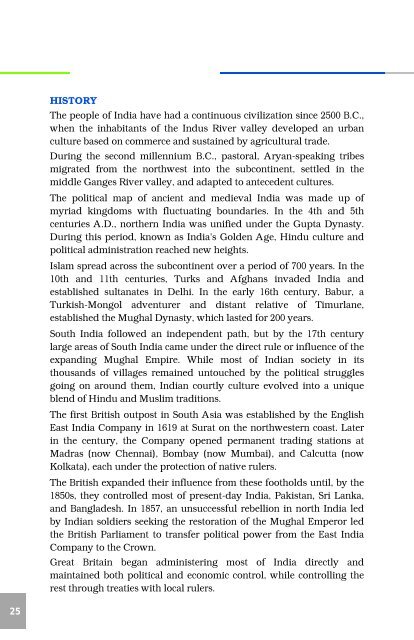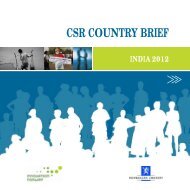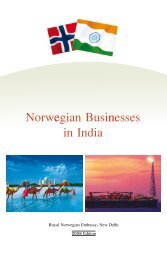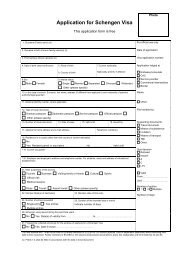2010 Booklet.pdf - Norway - the official site in India
2010 Booklet.pdf - Norway - the official site in India
2010 Booklet.pdf - Norway - the official site in India
Create successful ePaper yourself
Turn your PDF publications into a flip-book with our unique Google optimized e-Paper software.
HISTORY<br />
The people of <strong>India</strong> have had a cont<strong>in</strong>uous civilization s<strong>in</strong>ce 2500 B.C.,<br />
when <strong>the</strong> <strong>in</strong>habitants of <strong>the</strong> Indus River valley developed an urban<br />
culture based on commerce and susta<strong>in</strong>ed by agricultural trade.<br />
Dur<strong>in</strong>g <strong>the</strong> second millennium B.C., pastoral, Aryan-speak<strong>in</strong>g tribes<br />
migrated from <strong>the</strong> northwest <strong>in</strong>to <strong>the</strong> subcont<strong>in</strong>ent, settled <strong>in</strong> <strong>the</strong><br />
middle Ganges River valley, and adapted to antecedent cultures.<br />
The political map of ancient and medieval <strong>India</strong> was made up of<br />
myriad k<strong>in</strong>gdoms with fluctuat<strong>in</strong>g boundaries. In <strong>the</strong> 4th and 5th<br />
centuries A.D., nor<strong>the</strong>rn <strong>India</strong> was unified under <strong>the</strong> Gupta Dynasty.<br />
Dur<strong>in</strong>g this period, known as <strong>India</strong>'s Golden Age, H<strong>in</strong>du culture and<br />
political adm<strong>in</strong>istration reached new heights.<br />
Islam spread across <strong>the</strong> subcont<strong>in</strong>ent over a period of 700 years. In <strong>the</strong><br />
10th and 11th centuries, Turks and Afghans <strong>in</strong>vaded <strong>India</strong> and<br />
established sultanates <strong>in</strong> Delhi. In <strong>the</strong> early 16th century, Babur, a<br />
Turkish-Mongol adventurer and distant relative of Timurlane,<br />
established <strong>the</strong> Mughal Dynasty, which lasted for 200 years.<br />
South <strong>India</strong> followed an <strong>in</strong>dependent path, but by <strong>the</strong> 17th century<br />
large areas of South <strong>India</strong> came under <strong>the</strong> direct rule or <strong>in</strong>fluence of <strong>the</strong><br />
expand<strong>in</strong>g Mughal Empire. While most of <strong>India</strong>n society <strong>in</strong> its<br />
thousands of villages rema<strong>in</strong>ed untouched by <strong>the</strong> political struggles<br />
go<strong>in</strong>g on around <strong>the</strong>m, <strong>India</strong>n courtly culture evolved <strong>in</strong>to a unique<br />
blend of H<strong>in</strong>du and Muslim traditions.<br />
The first British outpost <strong>in</strong> South Asia was established by <strong>the</strong> English<br />
East <strong>India</strong> Company <strong>in</strong> 1619 at Surat on <strong>the</strong> northwestern coast. Later<br />
<strong>in</strong> <strong>the</strong> century, <strong>the</strong> Company opened permanent trad<strong>in</strong>g stations at<br />
Madras (now Chennai), Bombay (now Mumbai), and Calcutta (now<br />
Kolkata), each under <strong>the</strong> protection of native rulers.<br />
The British expanded <strong>the</strong>ir <strong>in</strong>fluence from <strong>the</strong>se footholds until, by <strong>the</strong><br />
1850s, <strong>the</strong>y controlled most of present-day <strong>India</strong>, Pakistan, Sri Lanka,<br />
and Bangladesh. In 1857, an unsuccessful rebellion <strong>in</strong> north <strong>India</strong> led<br />
by <strong>India</strong>n soldiers seek<strong>in</strong>g <strong>the</strong> restoration of <strong>the</strong> Mughal Emperor led<br />
<strong>the</strong> British Parliament to transfer political power from <strong>the</strong> East <strong>India</strong><br />
Company to <strong>the</strong> Crown.<br />
Great Brita<strong>in</strong> began adm<strong>in</strong>ister<strong>in</strong>g most of <strong>India</strong> directly and<br />
ma<strong>in</strong>ta<strong>in</strong>ed both political and economic control, while controll<strong>in</strong>g <strong>the</strong><br />
rest through treaties with local rulers.<br />
25







